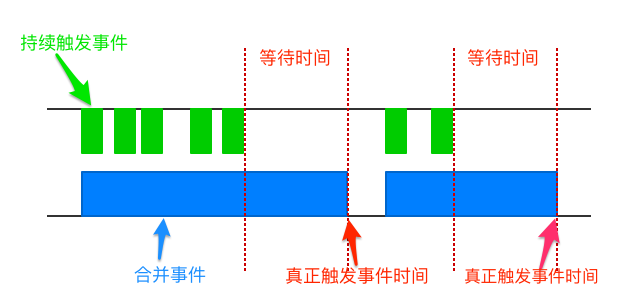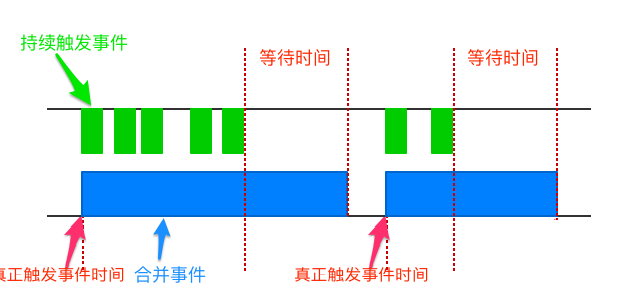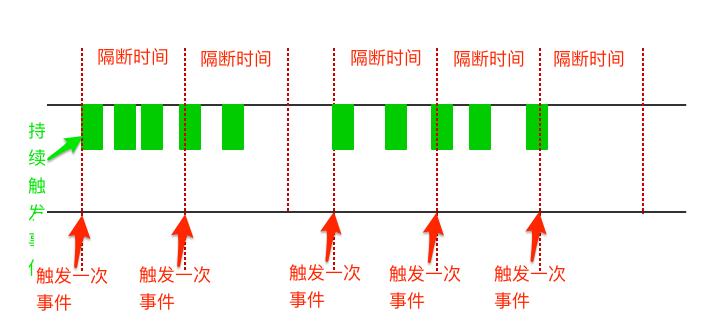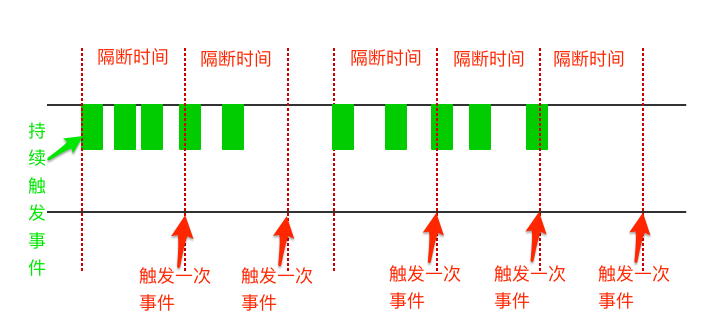窗口的resize、scroll、输入框内容校验等操作时,如果这些操作处理函数是较为复杂或页面频繁重渲染等操作时,在这种情况下如果事件触发的频率无限制,会加重浏览器的负担,导致用户体验非常糟糕。此时我们可以采用debounce(防抖)和throttle(节流)的方式来减少触发的频率,同时又不影响实际效果。
eg:搜索框的请求优化,输入搜索词条需要立即触发搜索请求时,防抖和节流可以将多个请求合并为一个请求
github笔记传送门,走过路过 star 一个?
首先准备 html 文件中代码如下:
<div id="content" style="height:150px;line-height:150px;text-align:center; color: #fff;background-color:#ccc;font-size:80px;"></div>
<script>
var num = 1;
var content = document.getElementById('content');
function count() {
content.innerHTML = num++;
};
content.onmousemove = count;
</script>
防抖
debounce(防抖),简单来说就是防止抖动。
当持续触发事件时,debounce 会合并事件且不会去触发事件,当一定时间内没有触发再这个事件时,才真正去触发事件。
非立即执行版

非立即执行版的意思是触发事件后函数不会立即执行,而是在 n 秒后执行,如果在 n 秒内又触发了事件,则会重新计算函数执行时间。
const debounce = (func, wait, ...args) => {
let timeout;
return function(){
const context = this;
if (timeout) clearTimeout(timeout);
timeout = setTimeout(() => {
func.apply(context, args)
},wait);
}
}
如此调用:
content.onmousemove = debounce(count,1000);

立即执行版

立即执行版的意思是触发事件后函数会立即执行,然后 n 秒内不触发事件才能继续执行函数的效果。
const debounce = (func, wait, ...args) => {
let timeout;
return function(){
const context = this;
if (timeout) cleatTimeout(timeout);
let callNow = !timeout;
timeout = setTimeout(() => {
timeout = null;
},wait)
if(callNow) func.apply(context,args)
}
}

结合版
/**
* @desc 函数防抖
* @param func 函数
* @param wait 延迟执行毫秒数
* @param immediate true 表立即执行,false 表非立即执行
*/
function debounce(func,wait,immediate) {
var timeout;
return function () {
var context = this;
var args = arguments;
if (timeout) clearTimeout(timeout);
if (immediate) {
var callNow = !timeout;
timeout = setTimeout(function(){
timeout = null;
}, wait)
if (callNow) func.apply(context, args)
}
else {
timeout = setTimeout(function(){
func.apply(context, args)
}, wait);
}
}
}
节流
throttle(节流),当持续触发事件时,保证隔间时间触发一次事件。
持续触发事件时,throttle 会合并一定时间内的事件,并在该时间结束时真正去触发一次事件。
时间戳版

在持续触发事件的过程中,函数会立即执行,并且每 1s 执行一次。
const throttle = (func, wait, ...args) => {
let pre = 0;
return function(){
const context = this;
let now = Date.now();
if (now - pre >= wait){
func.apply(context, args);
pre = Date.now();
}
}
}

定时器版

在持续触发事件的过程中,函数不会立即执行,并且每 1s 执行一次,在停止触发事件后,函数还会再执行一次。
const throttle = (func, wait, ...args) => {
let timeout;
return function(){
const context = this;
if(!timeout){
timeout = setTimeout(() => {
timeout = null;
func.apply(context,args);
},wait)
}
}
}

结合版
其实时间戳版和定时器版的节流函数的区别就是,时间戳版的函数触发是在时间段内开始的时候,而定时器版的函数触发是在时间段内结束的时候。
/**
* @desc 函数节流
* @param func 函数
* @param wait 延迟执行毫秒数
* @param type 1 表时间戳版,2 表定时器版
*/
function throttle(func, wait ,type) {
if(type===1){
var previous = 0;
}else if(type===2){
var timeout;
}
return function() {
var context = this;
var args = arguments;
if(type===1){
var now = Date.now();
if (now - previous > wait) {
func.apply(context, args);
previous = now;
}
}else if(type===2){
if (!timeout) {
timeout = setTimeout(function() {
timeout = null;
func.apply(context, args)
}, wait)
}
}
}
}
underscore 源码
/**
* underscore 防抖函数,返回函数连续调用时,空闲时间必须大于或等于 wait,func 才会执行
*
* @param {function} func 回调函数
* @param {number} wait 表示时间窗口的间隔
* @param {boolean} immediate 设置为ture时,是否立即调用函数
* @return {function} 返回客户调用函数
*/
_.debounce = function(func, wait, immediate) {
var timeout, args, context, timestamp, result;
var later = function() {
// 现在和上一次时间戳比较
var last = _.now() - timestamp;
// 如果当前间隔时间少于设定时间且大于0就重新设置定时器
if (last < wait && last >= 0) {
timeout = setTimeout(later, wait - last);
} else {
// 否则的话就是时间到了执行回调函数
timeout = null;
if (!immediate) {
result = func.apply(context, args);
if (!timeout) context = args = null;
}
}
};
return function() {
context = this;
args = arguments;
// 获得时间戳
timestamp = _.now();
// 如果定时器不存在且立即执行函数
var callNow = immediate && !timeout;
// 如果定时器不存在就创建一个
if (!timeout) timeout = setTimeout(later, wait);
if (callNow) {
// 如果需要立即执行函数的话 通过 apply 执行
result = func.apply(context, args);
context = args = null;
}
return result;
};
};
- 对于按钮防点击来说的实现:一旦我开始一个定时器,只要我定时器还在,不管你怎么点击都不会执行回调函数。一旦定时器结束并设置为 null,就可以再次点击了。
- 对于延时执行函数来说的实现:每次调用防抖动函数都会判断本次调用和之前的时间间隔,如果小于需要的时间间隔,就会重新创建一个定时器,并且定时器的延时为设定时间减去之前的时间间隔。一旦时间到了,就会执行相应的回调函数。
/**
* underscore 节流函数,返回函数连续调用时,func 执行频率限定为 次 / wait
*
* @param {function} func 回调函数
* @param {number} wait 表示时间窗口的间隔
* @param {object} options 如果想忽略开始函数的的调用,传入{leading: false}。
* 如果想忽略结尾函数的调用,传入{trailing: false}
* 两者不能共存,否则函数不能执行
* @return {function} 返回客户调用函数
*/
_.throttle = function(func, wait, options) {
var context, args, result;
var timeout = null;
// 之前的时间戳
var previous = 0;
// 如果 options 没传则设为空对象
if (!options) options = {};
// 定时器回调函数
var later = function() {
// 如果设置了 leading,就将 previous 设为 0
// 用于下面函数的第一个 if 判断
previous = options.leading === false ? 0 : _.now();
// 置空一是为了防止内存泄漏,二是为了下面的定时器判断
timeout = null;
result = func.apply(context, args);
if (!timeout) context = args = null;
};
return function() {
// 获得当前时间戳
var now = _.now();
// 首次进入前者肯定为 true
// 如果需要第一次不执行函数
// 就将上次时间戳设为当前的
// 这样在接下来计算 remaining 的值时会大于0
if (!previous && options.leading === false) previous = now;
// 计算剩余时间
var remaining = wait - (now - previous);
context = this;
args = arguments;
// 如果当前调用已经大于上次调用时间 + wait
// 或者用户手动调了时间
// 如果设置了 trailing,只会进入这个条件
// 如果没有设置 leading,那么第一次会进入这个条件
// 还有一点,你可能会觉得开启了定时器那么应该不会进入这个 if 条件了
// 其实还是会进入的,因为定时器的延时
// 并不是准确的时间,很可能你设置了2秒
// 但是他需要2.2秒才触发,这时候就会进入这个条件
if (remaining <= 0 || remaining > wait) {
// 如果存在定时器就清理掉否则会调用二次回调
if (timeout) {
clearTimeout(timeout);
timeout = null;
}
previous = now;
result = func.apply(context, args);
if (!timeout) context = args = null;
} else if (!timeout && options.trailing !== false) {
// 判断是否设置了定时器和 trailing
// 没有的话就开启一个定时器
// 并且不能不能同时设置 leading 和 trailing
timeout = setTimeout(later, remaining);
}
return result;
};
};